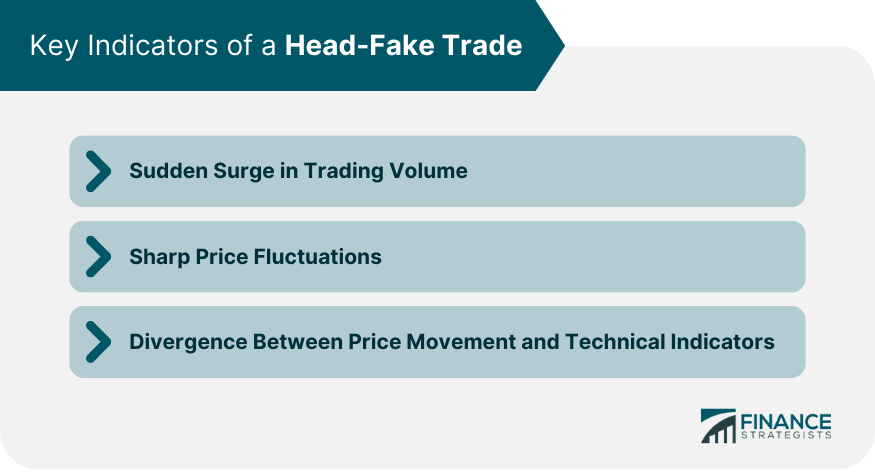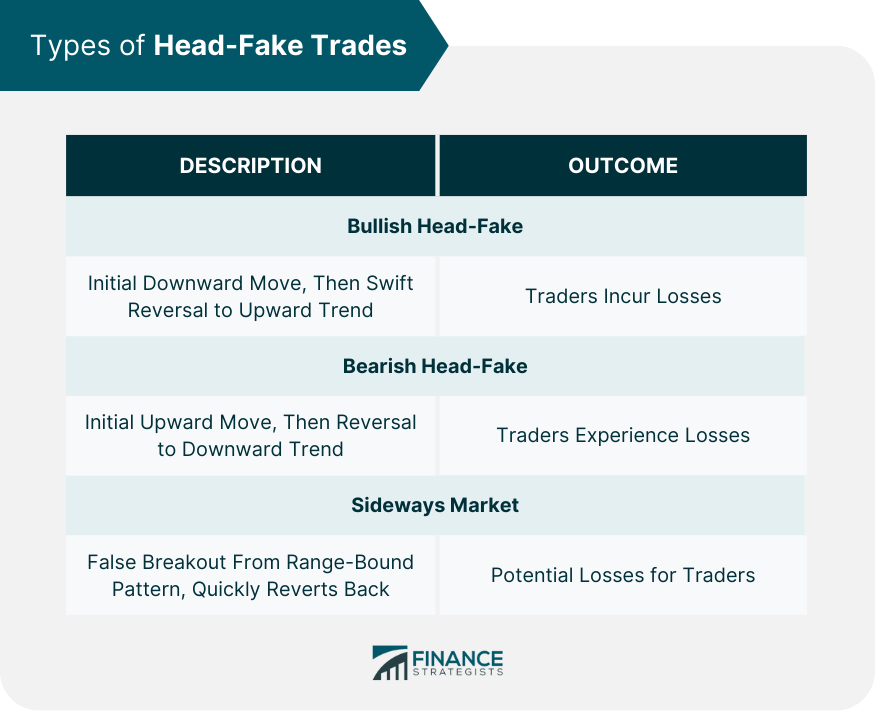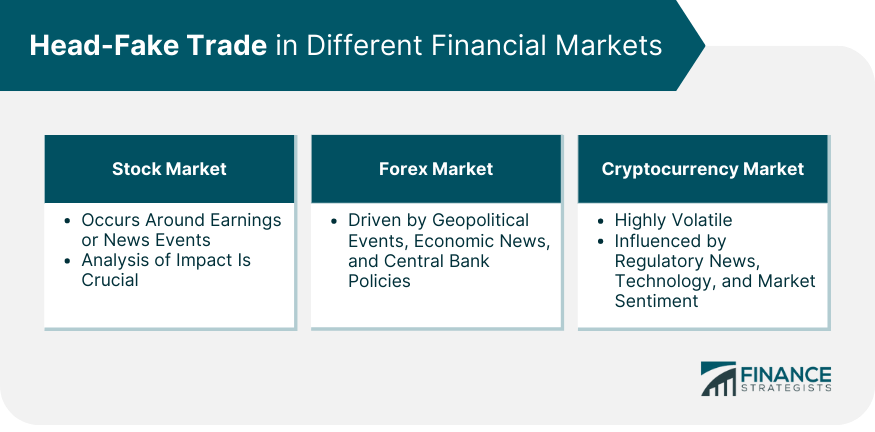A head-fake trade is a scenario in financial markets where an asset's price appears to be trending in one direction, only to abruptly reverse and move the opposite way. Originating from sports terminology, it describes a deceptive strategy where an initial movement is used to mislead before a swift change in direction. This concept is prevalent in stock, forex, and cryptocurrency markets. Traders, influenced by trends, technical indicators, or market sentiment, may predict a certain price movement. However, a swift market reversal—often triggered by high volatility, significant market news or events, drastic changes in market sentiment, or large institutional traders entering or exiting the market—can lead to losses for unprepared investors. Understanding head-fake trades is critical as it highlights the unpredictability of financial markets and underscores the importance of effective risk management. Recognizing a head-fake allows traders to adjust strategies, potentially minimizing losses or profiting from such market scenarios. An unexpected increase in the number of trades reflects heightened activity and interest from market participants. This increase might be the result of market participants reacting to perceived changes in an asset's value. Such a scenario is likely to create an environment conducive to a head-fake, as the heightened activity could mask the deceptive trend reversal that characterizes a head-fake. The rapid and dramatic price movements can hint at underlying market instability. While such fluctuations are not uncommon in financial markets, when they occur at an unusual rate or scale, they can signal an impending head-fake. Rapid price changes may create confusion or misconceptions about the market's direction, thereby setting the stage for the asset's price to reverse its course unexpectedly. Technical indicators are statistical calculations used by traders to predict future price movements. When these indicators diverge from the actual price trend, it signals a discrepancy between the market's expected behavior and its actual movement. Such a divergence can often be the precursor to a head-fake trade, indicating that the market is set to defy its anticipated trend and reverse direction unexpectedly. Several factors can trigger a head-fake trade. Some common causes include: Market News and Events: Significant news events or economic data releases can cause a sudden change in market sentiment, triggering a head-fake trade. Institutional Trading: Large trades executed by institutional investors or hedge funds can significantly influence the market, creating a temporary price movement that quickly reverses. Algorithmic Trading: High-frequency trading algorithms can sometimes create head-fake trades by executing large volumes of trades within a short period, causing temporary price spikes or drops. A bullish head-fake trade occurs when the price of an asset initially moves downwards, prompting traders to anticipate a further price drop. However, the price swiftly reverses course and starts to rise. Traders who took short positions expecting a downward trend are then caught off guard and may incur losses. In contrast, a bearish head-fake trade happens when the price initially rises before reversing and moving downwards. Traders who opened long positions expecting a continued upward trend might suffer losses when the market turns bearish. A sideways market head-fake occurs when the price seems to break out of a range-bound pattern, prompting traders to anticipate a strong move in the breakout direction. However, the price quickly reverses back into the range, leading to potential losses for traders who took positions based on the apparent breakout. Risk management is critical when dealing with head-fake trades. Some strategies include setting stop-loss orders to limit potential losses, diversifying trading positions to spread risk, and avoiding over-leveraging, which can amplify losses during head-fakes. Traders can capitalize on head-fake trades by implementing certain trading techniques. One common strategy is to wait for confirmation of a trend before entering a position. For instance, traders might wait for the price to make a significant move in the anticipated direction or for specific technical indicators to confirm the trend before initiating a trade. Another technique is to use a contrarian strategy, where traders intentionally take positions opposite to the prevailing market trend, anticipating a potential head-fake. This technique can be profitable but is also risky and requires precise timing and a solid understanding of market dynamics. Patience and timing play crucial roles in dealing with head-fake trades. Traders must resist the urge to jump on perceived trends without adequate confirmation. Patience allows traders to wait for more reliable signs of market direction. Similarly, precise timing is vital when entering or exiting trades during potential head-fakes to minimize losses and maximize potential gains. In the stock market, head-fake trades often occur around earnings announcements or significant news events related to specific companies. Traders need to monitor these events closely and analyze their potential impact on stock prices. Head-fake trades in the forex market are often driven by geopolitical events, economic news releases, or changes in central bank policies. Given the 24/5 nature of forex markets, traders must stay abreast of international news and events that could trigger a head-fake. Cryptocurrency markets are notoriously volatile, making them prime territory for head-fake trades. Factors such as regulatory news, technological developments, and market sentiment can cause rapid price swings and potential head-fakes. A head-fake trade in financial markets is an abrupt price change in a particular direction that quickly reverses, often leading to significant volatility. These unpredictable trades, typically triggered by major market news, institutional or algorithmic trading, can present both a challenge and an opportunity for traders. They come in different forms, such as bullish, bearish, or sideways market head-fakes, each with unique implications. To navigate head-fake trades effectively, a trader must employ robust risk management strategies, meticulous analysis, and suitable trading techniques. These could involve setting stop-loss orders, diversifying positions, awaiting trend confirmation, and using contrarian strategies. While technology, like trading algorithms and AI, can be helpful in identifying these trades, they should be used in tandem with conventional trading tools and tactics. Given the complexity of dealing with head-fake trades, enlisting the help of a skilled wealth management firm can be beneficial. What Is Head-Fake Trade?
Key Indicators of a Head-Fake Trade
Sudden Surge in Trading Volume
Sharp Price Fluctuations
Divergence Between Price Movement and Technical Indicators

Potential Causes of a Head-Fake Trade
Types of Head-Fake Trades
Bullish Head-Fake Trade
Bearish Head-Fake Trade
Sideways Market Head-Fake Trade

Strategies for Handling a Head-Fake Trade
Risk Management in the Face of a Head-Fake Trade
Trading Techniques to Capitalize on a Head-Fake Trade
Patience and Timing in a Head-Fake Trade
Head-Fake Trade in Different Financial Markets
Head-Fake Trade in the Stock Market
Head-Fake Trade in the Forex Market
Head-Fake Trade in the Cryptocurrency Market

Final Thoughts
Head-Fake Trade FAQs
A head-fake trade is a situation where the price of an asset appears to move in a certain direction but then reverses and moves in the opposite direction.
Head-fake trades can be triggered by various factors, including market news, large trades by institutional investors, and high-frequency trading algorithms.
Traders often use a combination of technical analysis tools, market sentiment, and fundamental analysis to identify potential head-fake trades.
Yes, trading algorithms, AI, and machine learning can aid in predicting head-fake trades, but they are not foolproof and should be used alongside other trading strategies.
Head-fake trades can increase market volatility, influence market sentiment, disrupt trading strategies, and lead to significant financial losses if not properly managed.
True Tamplin is a published author, public speaker, CEO of UpDigital, and founder of Finance Strategists.
True is a Certified Educator in Personal Finance (CEPF®), author of The Handy Financial Ratios Guide, a member of the Society for Advancing Business Editing and Writing, contributes to his financial education site, Finance Strategists, and has spoken to various financial communities such as the CFA Institute, as well as university students like his Alma mater, Biola University, where he received a bachelor of science in business and data analytics.
To learn more about True, visit his personal website or view his author profiles on Amazon, Nasdaq and Forbes.











